Fussy or “picky” eating in childhood is normal (and common), but that doesn’t make it any easier for the parents who have to deal with it day in and day out.
You might want to check out our previous post – How do you know if your child is a fussy eater or a problem feeder?
Many people assume that if a child is hungry enough, they will eat. After all, they aren’t going to starve themselves! Whilst this is true for about 94-96% of children, we cannot be so blasé about the other 4 – 6% experiencing feeding problems. For these children eating either hurts or doesn’t work, and no amount of hunger is going to overcome that fact.
Why won’t they eat?
Most children typically go through a fussy eating phase as part of a developmental stage, such as a 2 year old trying to assert their independence. Furthermore, a child’s appetite and eating habits will fluctuate in the same way as an adult’s does, such as when they are feeling ill, tired or stressed.
There can be other reasons why children refuse to eat however. Some may refuse because they experience (or have previously experienced) pain or discomfort due to reflux, intolerances, constipation, cardiac or breathing issues etc. Other children may have immature oro-motor skills, which makes tasks such as biting, chewing, swallowing, moving food around the mouth and even keeping lips closed to keep the food in difficult.
As adults, we often take for granted how easy it is for us to eat. It’s something most of us do without even thinking about it, not realising that feeding is actually only instinctive for the first month of a newborn’s life. After that, everything is learnt. Many people think of eating as a 2 step process – you sit down and you eat. End of story. In reality however, there are between 25 and 32 steps in the process of learning to eat a new food. For children on the autism spectrum there can be as many as 50 steps!
Therefore, some children (particularly those on the autism spectrum) may refuse to eat because they genuinely find something about the mealtime difficult to cope with. Maybe it’s a taste or texture they aren’t comfortable with, maybe it’s a smell that is overpowering to them, maybe it’s a sound, like food crunching with each bite that causes them anxiety.
There are many different reasons why a child might present as a fussy eater, but regardless of the reason, the question remains… What can we do about it?
Here are 10 tips to keep in mind when dealing with fussy eaters …
1. Start mealtimes calmly

When your child gets upset or stressed, a surge of adrenalin is released. This is a problem because adrenalin suppresses appetite. To have the best chance of a successful mealtime with a fussy eater, we need to keep everyone calm!
If your child is engrossed in a game, book or TV show and you announce “dinner’s ready”, and then waltz in and turn the TV off, there will be fireworks! Instead, give your child a verbal warning such as, “5 more minutes of that game and then it’s dinner time”.
Sometimes though, a verbal warning alone isn’t enough. In that case, try to get your child involved in a transition activity such as washing their hands or choosing which plate they would like to use, to help them move from one activity to the next. The goal is to help them calm down before food is even in the picture.
If your child is really upset blowing bubbles can be a useful way to help them calm down, as taking deep breaths activates endorphins, which counteracts adrenalin.
2. Set regular mealtimes
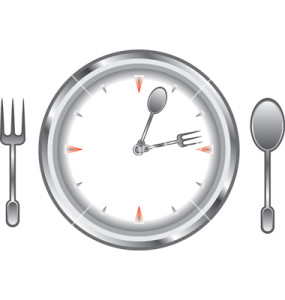
On average children (and most adults) need to eat 5 – 6 times per day or approximately every 2.5 – 3 hours. The timing of the meals isn’t an issue (e.g. breakfast might be at 6.30am or 8am depending on when your child wakes) but the interval between meals is important.
The problem with children who graze throughout the day and eat sooner than 2 – 2.5 hours, is that they often just eat enough to take the edge off their hunger. As a result they can consume up to 50% fewer calories in a day than if they were having set mealtimes. So if they don’t eat at a particular mealtime, take the plate away and just wait to offer them something else at the next meal or snack time. Don’t leave the plate out for them to keep coming back to.
3. Be realistic
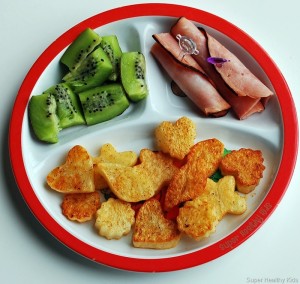
I have heard many parents express their concerns that their child isn’t eating enough, only to discover that the amount of food they are giving their child is enough to feed a small army!
Children, fussy eaters in particular, are easily overwhelmed by seeing too much on their plate. This is true in terms of both quantity and variety. Have as much food as you like on the table, but try to only put 3 different foods on your child’s plate at a time, preferably a starchy food (e.g. rice, pasta, potato), a protein (e.g. lean meat, egg, dairy) and a fruit or vegetable. Try as best as you can to make at least one out of three foods on the plate, something you know your child likes or will eat. A general rule of thumb is to give one tablespoon of each food, for each year of their age (up until the age of 10).
Don’t forget that for some children to become more comfortable with mealtimes or particular foods, they need to begin with steps such as coping with being in the same room as the food, before they are anywhere near ready to smell, touch, taste and eat the food.
20 minutes is an average time for typical meals, although fussy eaters tend to take longer. However, mealtimes should not exceed 45 minutes because by that point a child may be burning more calories than they are consuming.
4. Treat snacks as meals too

Appetite is affected by lots of different factors such as stress, illness and fatigue. Sometimes you don’t feel like eating much and other days you could eat a horse. Children are no different. How much they eat will fluctuate day-to-day.
Therefore, try to treat snacks in the same way that you would a meal. That is, provide some kind of starch, a type of protein and some fruit or vegetable. For example, instead of giving your child a whole apple as a snack, you might give them some apple slices as well as some cheese and crackers, or some toast fingers and carrot sticks to dip in hummus.
By doing this, you are giving your child a greater opportunity to get nutrients from the different food groups across the whole day, instead of running the risk of them missing out on an entire food group as a result of refusing one meal.
5. Do not force your child to eat

Remember this saying… You can lead a horse to water, but you can’t make it drink.
If your child has decided they are not going to eat something, then really there’s not much you can do about it. Yes it is annoying, infuriating even, but do your best to resist the urge to bribe, plead or threaten your child to eat. Here’s why…
Firstly, studies have shown that being given a reward for eating a food, leads to less liking for that food. So the old, “If you finish all your peas you can have some ice-cream” chestnut is a no go! Bribes are out.
Similarly, studies have also shown that higher levels of parental pressure are associated with lower levels of child intake and weight, and higher ratings of child pickiness. So pleading or threatening them to eat can actually make it worse.
The good news is that the studies did find something that was shown to enhance a child’s liking of that food…. verbal praise! Hooray! Finally something we can do! Don’t fall into the trap of only praising chewing and swallowing though.
Remember that there are at least 25 steps involved in learning to eat so there are lots of things you can praise even if your child doesn’t eat anything.
Praise them for any positive food behaviour and be specific! Instead of just saying “You’re being very good” tell them why, for example “I’m so happy that you’re sitting at the table with us”, “Wow Sarah! I like how you tasted your chicken” or, “I saw you smelling your soup Billy. Good work!”
6. Ignore unwanted behaviour
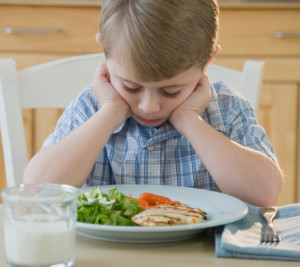
When thinking about your child’s behaviour around mealtimes, it can help to try and think about what the real aim of that behaviour might be. Are they trying to escape from something they don’t like? Are they trying to get something they want? Or are they doing it simply because it feels good?
One of the most common traps parents fall into when dealing with fussy eaters, is giving attention to the child when they are refusing to eat. Remember, it doesn’t matter whether you frame it positively (“Come on, you’re such a good girl just have a little bite”), or not (“If you don’t have a bite you are going to go to bed right now!”), attention is attention. So if a child refuses to eat (or constantly spits out their food, or carries on with any kind of unwanted behaviour) and receives attention for it, the end result is that they will continue to use the unwanted behaviour to get more attention. So, in these instances sometimes the best thing you can do is ignore it. It is hard (especially if you’ve spent a long time cooking something!) but try to stay calm and say, “Why don’t you have a taste? It’s really yummy” and if they continue to refuse just calmly reply, “Ok, you can try it again another day” and move on.
The focus of the meal should be the food, not the child, however we do want to give praise for any good attempts of eating or exploring various elements (sight, smell, touch, taste) of the food. As such, getting your child to stay at the table even if they aren’t eating is key. If your child refuses to eat and you send them to time out, they are actually getting what they want (by escaping from the food) and will continue to use this method over and over. If you can ignore the refusals and instead praise them for what they are doing well, you will be making it much easier for yourself in the long run.
7. Focus on skills first – manners later

Children need to play with their food. That is how they learn about the various physical properties such as how hard it is and how it breaks apart. I know this is going to make lots of people cringe, but when it comes to fussy eaters, mess really is best.
Sometimes it is up to you as the parent and teacher, to throw your manners out the window (temporarily of course) in order to help a child learn a new skill. For example, as a baby is learning how to chew and eat solid food, parents need to sit in front of their baby and chew food with their mouth open so that the baby can actually see what is going on inside your mouth. Otherwise, if your child sees you take a bite, then watches you close your mouth for a few seconds before opening it up again with no food to be seen, they struggle to make sense of where the food has gone, let alone understand how chewing was involved.
Clearly, I’m not suggesting you should cheer when your 7 year old throws spaghetti on the wall. There have to be limits of course, but children do need to be able to poke and prod their food. They also need to feel comfortable that if they put it in their mouth and can’t manage it for whatever reason, that they will not be punished for taking the food out again.
A quick note about spitting food out… Spitting is part of the normal developmental process of learning to eat. Children need to feel safe that they can get the food out, if they are struggling to get it down. They need to learn this as a protective mechanism so they don’t choke.
8. Don’t make the food perfect
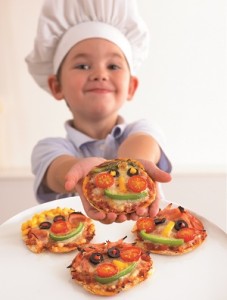
There is a lot of advice out there that encourages parents to entice fussy eaters by making the food look fun. I completely agree with this. After all, carrots on a plate are boring, but as wheels on a train they become much more interesting.
We need to be careful though, because the more perfect you make their food, the more perfect they need it. This is especially true between the ages of 2-3 years, 5-7 years and 9-11 years.
Some children even develop food jags which can become very difficult for families to manage. A food jag is when the child eats the same food, prepared the same way every day or at every meal. The problem is that children eventually get burnt out on these foods. Whilst a 2 week break is usually long enough for most children to start eating that food again, there are some who continue to refuse it.
The best way to prevent a food jag is to try and offer a food once every other day. If your child does not have enough foods in their range to eat 3 different things during 3 different meals, try to change the shape, colour, taste or texture instead. It must be a change that is large enough for the child to notice, but small enough that they will still eat it. E.g. offering baked potato one night and mashed the next.
9. Don’t give up!

Fussy eating wears parents down. I think most of us start out with the best intentions but the uncertainty of whether your child is eating enough can lead to some parents becoming short order cooks – with some making a different meal for everyone in the family.
It takes on average 10 times for a child to try a particular food and get positive reinforcement before adding it to their repertoire. Keep in mind that this is not 10 days in a row! Older children may take 15 times to learn to accept a new taste.
So even if that broccoli is left on their plate at the end of each meal, give lots of encouragement, take a deep breath and just keep trying. If you give up and stop offering it then they will never learn to like it. “The most important determinant of a child’s liking for a particular food is the extent to which it is familiar”*.
This is also why parents need to be careful with hiding food. I definitely understand the appeal and freely admit that I too have secretly added grated vegetables into pasta sauces without my kids’ knowledge. After all, how can sneaking in something nutritious possibly be bad? Look, sometimes you need to get your kids eating more calories and nutrients and this is a way to do that. But there is a downside… For starters, if your child doesn’t know they are eating it, then they are not being exposed to it and therefore cannot learn to like it and will not add that food to their range. Secondly, you run the risk of them finding out and then rejecting more foods because they don’t trust them (or you). Finally, it can send a confusing message to the child. For example, chocolate cake and chocolate biscuits are only treats we have occasionally, but you can have this chocolate mousse (because it’s secretly made with avocado) every night! So there are both pros and cons to keep in mind!
10. Make mealtimes social

Mealtimes are supposed to be social! Children learn so much when they have someone modelling appropriate behaviours for them. Having an adult sit and eat with a child at the same time can be instrumental in getting fussy eaters to enjoy mealtimes and maybe even try new foods. If you can arrange for your child to eat with other children sometimes, that too can be a great incentive for them to try new things. Go for a picnic on the weekend if the weather is nice. Take your children to the supermarket and ask them to help you find the ingredients for dinner. Get them to help prepare the meal if there are jobs they can do. Involve them in the process as much as you can, and then when it’s time to eat, get rid of the distractions.
When a child is distracted during mealtimes by TV, toys or books, they shift into a reflexive eating mode. This means that they come to rely on having the distractor present in order to eat. Distractions also build up over time and before you know it the distractor has become a reward/bribe – “Have one more bite and then I’ll read the next page”, or “I’m not turning the TV back on until you swallow what is in your mouth!”. As you’ve already read, these types of warnings will only make the child like the food even less! If you are using distractions at mealtimes don’t try to cut them out cold turkey! Slowly cut them back and preferably use things that disappear, such as bubbles, to get you back on track.
So there you have it…
If you are dealing with a fussy eater, try not to automatically assume that your mealtime battles are a result of your child being lazy or just trying to test you. For most children going through a “picky” stage, it’s just that – a stage, and it will pass in time. However for other children, eating is HARD!
Generally speaking, if your child seems healthy and is alert and active, then they are probably eating enough. Remember, instead of focussing on what your child eats (or does not eat) at each meal, or even each day, keep a diary of everything they eat and drink over a week. This will give you a better indication of their overall intake and will allow for the normal variation seen day to day.
However, if you have any doubts you should speak to your GP, your child and family health nurse or an accredited practising dietitian to check your child’s growth. Then, if your child is experiencing feeding difficulties they will be able to direct you to other professionals for additional help, such as speech pathologists, occupational therapists and even psychologists.
Remember… Sharing is caring. You can also like our Facebook page for more.
*Cooke, L. (2007) The importance of exposure for healthy eating in childhood: A review. Journal of Human Nutrition and Diet, 20, 294-301





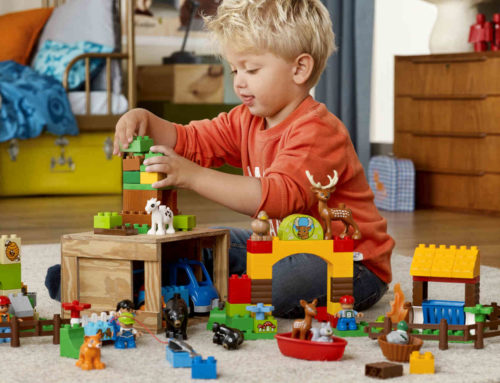

Leave A Comment